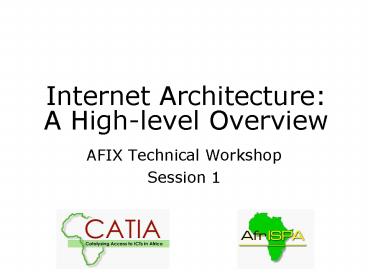Internet Architecture: A Highlevel Overview PowerPoint PPT Presentation
1 / 28
Title: Internet Architecture: A Highlevel Overview
1
Internet Architecture A High-level Overview
- AFIX Technical Workshop
- Session 1
2
Outline of content
- The underlying structure of the Internet and the
forces that have shaped it. - The concepts of peering and transit
- A general overview of exchange points (IXPs)
- The state of IXPs and peering in Afrca
3
History Where it all started
- Way back in the dawn of Internet time (1969!)
ARPANET - 1972 DARPA-sponsored Internetting project to
develop communication protocols for linked packet
networks. - TCP/IP written early 1970s
4
Some key decisions
- Independent networks no modification to reach
Internet - Networks linked by gateways which transmit data
packets but retain no information about traffic - Use the fastest available route for each packet
- Gateways to route traffic without discrimination
- Operating principles freely available to all
5
Towards the net as we know it
- 1970s e-mail, first small-scale commercial
services, Usenet, Unix networking for
universities - 1980s Bitnet, CSNet, EuNet, EARN.
- Internet hosts 1969 4 1981 210 1984
1,000 1986 5,000 1987 28,000 1989
130,000
6
Key growth enablers
- The Domain Name System (DNS)
- Replaced single static host file database with
dynamic hierarchical structure. - NSFNet
- US backbone for all university traffic.
- Broke bottleneck, encouraged use.
- Exclusion of commercial users encouraged growth
of private ISPs (UUNET 1987).
7
1990s Birth of the web
- 1990 Hosts grew to 300,000 Archie (first
search engine) - 1991 Private access to NSFNet Tim Berners-Lee
developed HTTP and HTML - Internet A network of networks (infrastructure)
- Web Information space abstract!
8
Network Access Points
- 4 original NAPs, all in US, to provide access to
NSFNet (onramps) - Regional access providers developed to aggregate
traffic direct interconnection led to NSFNet
obsolescence. - Multiplication of peering and exchange points
9
The role of IXPs today
- The Internet would not exist without agreements
to exchange traffic!!! - Competitor ISPs must co-operate to serve their
clients - Two main forms of traffic exchange
- Transit sell access to all destinations in
routing table - Peering access to each others customers
10
The transit relationship
11
The peering relationship
12
To peer or not to peer?
13
- The overall structure of the Internet is one
where there is a strong business pressure to
create a rich mesh of interconnection at various
levels - Less easy for African ISPs to peer with
international providers whod rather sell
transit!
14
The Internet without peering
15
The Internet without peering
- Backhaul is expensive for both parties
- Not cost effective
16
IXPs shorten the chain
17
..and grow local bandwidth
18
The rationale for IXPs
- Two ISPs in a market Peer directly
- More than two Peer at an exchange point
- A facility operated by a single entity to
facilitate the exchange of Internet traffic
between three or more ISPs. - Closer cheaper, faster, more efficient
19
How an IXP works
- Major providers connect their networks and
exchange traffic - High-speed network or switch
- Simple concept - anyplace where providers come
together to exchange traffic
20
Exchange points
Gateways
IXP
ISPs connect at Internet Exchange Points to
exchange traffic
21
Conceptual Diagram of XP
Exchange Point Medium
Customer Router
Customer Router
Customer Router
22
Why use an Exchange Point?
- KEEP LOCAL TRAFFIC LOCAL!!
- ISPs within a region peer with each other at
local exchange - No need to have traffic go overseas only to come
back
USA
200-900ms
200-900ms
200-900ms
5-20ms
23
(No Transcript)
24
The African picture
- 1.5Gbps outgoing bandwidth (2002)
- 13Mbps intra-African!!!
- High international tariffs discourage multiple
links - Lack of peering has cascading effects eg many
African websites are hosted offshore!
25
Major issues for the African Internet
- International bandwidth prices are biggest
contributor to high costs - African users effectively subsidise international
transit providers! - Fibre optic links are few and expensive ?
reliance on satellite connectivity - High satellite latency ? slow speed, high prices
- Growth of Internet businesses is inhibited
26
The solution IXPs for Africa
- So far, 10 out of 53 countries have IXPs (2003
count) - More IXPs ? lower latency, lower costs, more
usage - Both national and regional IXPs needed
- Also needed regional carriers, more fibre optic
infrastructure investment
27
Obstacles
- Current providers (cable and satellite) have a
lot to lose - Many of these have close links to regulators and
governments - Regulatory regimes on the whole closed and
resistant to change - Sometimes ISPs themselves are unwilling to
co-operate
28
Solutions
- Education and lobbying!
- Players AFRISPA, AFIX-TF, CATIA, AFNOG
- This workshop is part of the process
- Later sessions will deal in more detail with the
practical and political issues.

